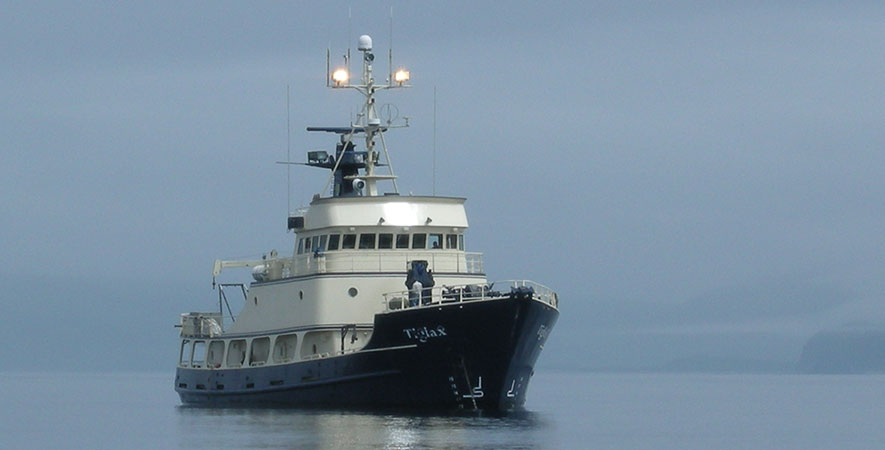Response Due: September 12, 2016
The US Fish and Wildlife Service has a requirement for a Marine Design Study To Modernize the Ocean Going 120ft Research Vessel R/V Tiglax.
The Research Vessel Tiglax was constructed in the mid-1980's for the Alaska Maritime NWR to support a scientific research program on the Alaska Maritime National Wildlife Refuge. It is currently 29 years old and USFWS is considering a mid-life refit.
Project Description: Prepare a Design Study Report for the U.S. Fish and Wildlife Service which would modernize the R/V Tiglax in preparation for another 30 years of service. Systems to be evaluated should be made compliant with current applicable federal standards and include ship's propulsion (from main engines, reduction gears, shafts and propellers), power generation plant (generator sets and power distribution panel), exhaust system routing for propulsion and generation, domestic hot and cold water distribution, and interior heating supply distribution system. In addition, any changes to these systems, if applicable, should be evaluated under 2 scenarios: current ship configuration and an optimized length increase of up to 20 feet.
Deliverables: For each ship system, recommended sections in a Design Study Report for the U.S. Fish and Wildlife Service would address, at a minimum: the recommended replacements for the major components/systems, configuration/layout/or design approach of the recommended system, estimated cost, and discussion if necessary. For more information, click here.
1. Propulsion: Tier IV engine choices for the ship in its present design state including, but not limited to, diesel or a diesel-electric propulsion option. Include a discussion of the routes of removal of old engines along with what reduction gears, shafts and propeller options need to be considered under the new propulsion system. Current system consists of (2) Caterpillar 3412 series engines, each rated 425hp, and their reduction gears consisting of (2) Twin Disc 530 M and shafts and propellers. All systems and replacements should match up to the replacement engines. Discuss the options for the removal of old engines from their beds and installation of recommended replacements to the current engine room configuration. Discuss what changes would need to be made to the existing propellers and shaft, if any.
2. Power generation plant: Tier IV engine choices for generation of electricity for the ship in its present design state. Present options for the replacement of the two generator plants which are currently two John Deere model 6076 ATF engines driving Kato 85 KW generators. New generators must meet the current ratings of Kilowatt (90) KW output of the existing engines. The serial numbers for the engines are: Starboard RG 6076A572588, Port RG 6076A568906. When considering the new generation plant, also evaluate condition and recommend, if necessary, a main generation panel upgrade that would control the distribution of electricity to the various circuit breaker panels throughout the ship.
3. Exhaust: Evaluate if the present exhaust plumbing for all engines in the engine room and Fiddly would need to be re-routed to utilize the proposed new equipment.
4. Hot and cold water distribution: Estimate costs for removal of old and installation of new interior domestic hot and cold water copper plumbing along with the replacement of the existing deck penetrations for that plumbing. Provide material replacement options for the old plumbing.
5. Provide cost estimate for the removal of old and the installation of new interior heating supply lines. Include an updated supply system manifold that would provide zones throughout the vessel where areas of the ship could be controlled independently. Provide options for replacement material and cost associated for new heating supply plumbing.
6. Lengthening: Evaluate any changes to systems 1-5, if applicable, under 2 scenarios: current ship configuration and an optimized length increase of up to 20 feet. Analyze and consider lengthening options costs for the R/V Tiglax that would be available without losing current performance capabilities (cruising 9-9.5 knots) and keeping efficiency (consuming 10.7 gallons an hour with main engine at 1000RPM). Presently there are only two ballast tanks forward and fuel oil is the primary ballast throughout the rest of the vessel. The purposes of the lengthening would be to increase the vessel's fuel, salt water ballast, and cargo capacity forward of the house, but yet cause no reduction of speed. Included in the design would be a new configuration of the existing cargo hatch if lengthened. The main weather deck space would remain primarily open deck for cargo forward of the house. No additional berthing or protected work space is required. Any new design should not cause any undue stress to the vessel in its increased length with its proposed new propulsion concepts.
Current ship specifications, stability report, hull lines drawing, and general arrangements are available by request.
The vessel is currently at sea but will be made available for inspection and speed trail testing prior to commencement of work.





